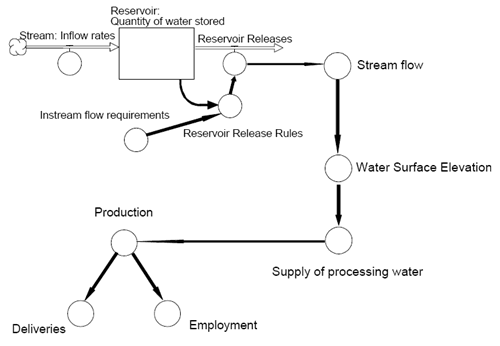A
DPS goes beyond a simple determination of future resource
conflicts; it
serves as a motivator for conflict resolution. Without knowing
your status quo future, you lack a basis for motivation. After all, if
you don’t know where you’re going, why plan any changes?
— Richard
Punnett (Huntington District, Corps of Engineers)
Whether
the subject is property lines, mountain elevations or drought
impacts,
measurements cannot be compared unless they are referenced to a
baseline. The third step of the Drought Preparedness Study (DPS)
planning method is to create a baseline
by describing the future without the DPS. This future without
the DPS is referred to as the status quo.
The
status quo can also provide motivation to a DPS team to produce results
because the status quo is a thoughtful, detailed and collective forecast
of what the future will bring if they do not.
The
effects of drought contingency plans, water laws and institutions as they
currently exist
should be reflected in the status quo. This should include the basic water
allocation system, of either riparian or appropriation type, any
site-specific programs, provisions for public trust and instream flows,
water conservation, transbasin diversions, and ground water management. The
DPS team must now try to quantify the problems that were identified in
general terms earlier in the process. To do that, they will:
- Build a model of the water management system, called a shared
vision model (the model should include the relationship between
shortfalls in water deliveries or levels and the impact on
stakeholders);
- Make hydrologic estimates of drought frequency, and select the
design droughts;
- Measure the performance of the water system during the design
droughts.
The
shared vision model of the status quo should define the relationship
between water and the stakeholders’ ultimate purposes for using water.
These relationships can be developed though interviews with principal
stakeholders. The specific situation of each stakeholder may even be
modeled during the interview. In the example illustrated below, one
stakeholder is an industry that uses water drawn from a stream as part of
its production process. In a severe drought, stream water
surfaces may drop so low that the intake is no longer submerged. Figure 2
illustrates how the relationship between stakeholders’ ultimate needs
and the water management system can be diagrammed.

Figure
2: Diagram of the system to
model the status quo
In this example, employment and deliveries — the factors most
directly related
to stakeholder profitability and viability — are dependent on
production, which in turn requires processing water. These
functions can
be defined based on existing and new studies and interviews with
the
stakeholders during the DPS. In the model, the supply of
processing water is a function of surface water elevations at the water
intake, which is in turn a function of streamflows
at that point. (These relationships may have been developed by
observation
or separate hydraulic modeling efforts.)
The
model also depicts the reservoir storage, inflow, release and the rules
governing releases. The shared vision model now includes all the
relationships necessary to determine how changes in inflows to the
reservoir or reservoir releases will affect employment and deliveries.
Shared
vision models often become an integral part of the DPS process because
such models allow planners to evaluate a larger number of variables and
more complex relationships than would otherwise be possible. Shared vision
models also allow planners to incorporate important information and data
such as long streamflow sequences, hydrologic and hydraulic concerns,
economic impacts, biological impacts and other concerns.
Shared
vision models are termed “shared vision” because the model is
constructed in a process in which stakeholders and decision
makers work
cooperatively to include factors and elements of interest to
them. Shared vision models should be used in every important water
resources evaluation where there is a gap between what
stakeholders and
decision makers need to know and what they are capable of
learning from
specialized models and databases that address parts of the
decision
domain.